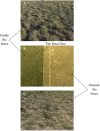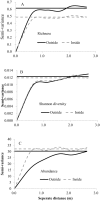A six-year grazing exclusion changed plant species diversity of a Stipa breviflora desert steppe community, northern China
- PMID: 29456890
- PMCID: PMC5815336
- DOI: 10.7717/peerj.4359
A six-year grazing exclusion changed plant species diversity of a Stipa breviflora desert steppe community, northern China
Abstract
Excluding grazers is one of most efficient ways to restore degraded grasslands in desert-steppe communities, but may negatively affect the recovery of plant species diversity. However, diversity differences between grazed and fenced grasslands in desert-steppe are poorly known. In a Stipa breviflora desert steppe community in Northern China, we established six plots to examine spatial patterns of plant species diversity under grazed and fenced conditions, respectively. We addressed three aspects of species diversity: (1) The logistic, exponential and power models were used to describe the species-area curve (SAR). Species richness, abundance and Shannon diversity values change differently with increasing sampling areas inside and outside of the fence. The best fitted model for SAR was the logistic model. Excluding grazers had a significant impact on the shape of SAR. (2) Variograms was applied to examine the spatial characteristics of plant species diversity. We found strong spatial autocorrelations in the diversity variables both inside and outside the fence. After grazing exclusion, the spatial heterogeneity decreased in species richness, increased in abundance and did not change in Shannon diversity. (3) We used variance partitioning to determine the relative contributions of spatial and environmental factors to plant species diversity patterns. Environmental factors explained the largest proportion of variation in species diversity, while spatial factors contributed little. Our results suggest that grazing enclosures decreased species diversity patterns and the spatial pattern of the S. breviflora desert steppe community was predictable.
Keywords: Diversity patterns; Spatial heterogeneity; Species-area curve; Variance partitioning.
Conflict of interest statement
The authors declare there are no competing interests.
Figures


Similar articles
-
[Effects of grazing intensity on spatial heterogeneity of the constructive species Stipa breviflora in desert steppe.].Ying Yong Sheng Tai Xue Bao. 2019 Sep;30(9):3046-3056. doi: 10.13287/j.1001-9332.201909.006. Ying Yong Sheng Tai Xue Bao. 2019. PMID: 31529880 Chinese.
-
Grazing intensity enhances spatial aggregation of dominant species in a desert steppe.Ecol Evol. 2019 Apr 26;9(10):6138-6147. doi: 10.1002/ece3.5197. eCollection 2019 May. Ecol Evol. 2019. PMID: 31161025 Free PMC article.
-
[Responses of the spatial distribution of Stipa breviflora to stocking rate at different scales].Ying Yong Sheng Tai Xue Bao. 2021 May;32(5):1735-1743. doi: 10.13287/j.1001-9332.202105.006. Ying Yong Sheng Tai Xue Bao. 2021. PMID: 34042368 Chinese.
-
Dominant species' dominant role and spatial stability are enhanced with increasing stocking rate.Sci Total Environ. 2020 Aug 15;730:138900. doi: 10.1016/j.scitotenv.2020.138900. Epub 2020 Apr 30. Sci Total Environ. 2020. PMID: 32388367
-
Cenozoic evolution of the steppe-desert biome in Central Asia.Sci Adv. 2020 Oct 9;6(41):eabb8227. doi: 10.1126/sciadv.abb8227. Print 2020 Oct. Sci Adv. 2020. PMID: 33036969 Free PMC article. Review.
Cited by
-
Litter accumulation alters the abiotic environment and drives community successional changes in two fenced grasslands in Inner Mongolia.Ecol Evol. 2019 Jul 23;9(16):9214-9224. doi: 10.1002/ece3.5469. eCollection 2019 Aug. Ecol Evol. 2019. PMID: 31463017 Free PMC article.
-
Litter addition decreases plant diversity by suppressing seeding in a semiarid grassland, Northern China.Ecol Evol. 2019 Aug 15;9(17):9907-9915. doi: 10.1002/ece3.5532. eCollection 2019 Sep. Ecol Evol. 2019. PMID: 31534703 Free PMC article.
-
Identification and Classification of Small Sample Desert Grassland Vegetation Communities Based on Dynamic Graph Convolution and UAV Hyperspectral Imagery.Sensors (Basel). 2023 Mar 6;23(5):2856. doi: 10.3390/s23052856. Sensors (Basel). 2023. PMID: 36905067 Free PMC article.
References
-
- Ali MM, Dicknson G, Murphy KJ. Predictors of plant diversity in a hyperarid desert wadi ecosystem. Journal of Arid Environments. 2000;45:215–230. doi: 10.1006/jare.2000.0631. - DOI
-
- Bai Y, Wu J, Clark CM, Pan Q, Zhang L, Chen S, Wang Q, Han X. Grazing alters ecosystem functioning and C:N:P stoichiometry of grasslands along a regional precipitation gradient. Journal of Applied Ecology. 2012;49(6):1204–1215. doi: 10.2307/23353500. - DOI
-
- Bello F, Vandewalle M, Reitalu T, Lep J, Prentice HC, Lavorel S, Sykes MT. Evidence for scale- and disturbance-dependent trait assembly patterns in dry semi-natural grasslands. Journal of Ecology. 2013;101(5):1237–1244. doi: 10.1111/1365-2745.12139. - DOI
-
- Bergholz K, May F, Giladi I, Ristow M, Ziv Y, Jeltsch F. Environmental heterogeneity drives fine-scale species assembly and functional diversity of annual plants in a semi-arid environment. Perspectives in Plant Ecology Evolution & Systematics. 2017;24:138–146. doi: 10.1016/j.ppees.2017.01.001. - DOI
LinkOut - more resources
Full Text Sources
Other Literature Sources
Miscellaneous

